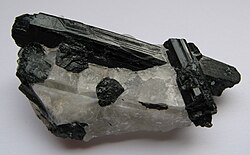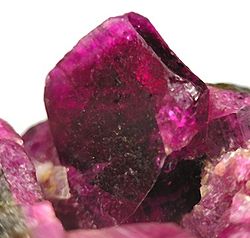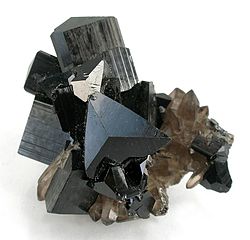Elbaite tourmaline (Oxford Pegmatite Field; Dunton Quarry, Newry, Maine, USA) 2 (43321961242)
Elbaite tourmaline from Maine, USA. (cut slice)
A mineral is a naturally-occurring, solid, inorganic, crystalline substance having a fairly definite chemical composition and having fairly definite physical properties. At its simplest, a mineral is a naturally-occurring solid chemical. Currently, there are over 5500 named and described minerals - about 200 of them are common and about 20 of them are very common. Mineral classification is based on anion chemistry. Major categories of minerals are: elements, sulfides, oxides, halides, carbonates, sulfates, phosphates, and silicates.
The silicates are the most abundant and chemically complex group of minerals. All silicates have silica as the basis for their chemistry. "Silica" refers to SiO2 chemistry. The fundamental molecular unit of silica is one small silicon atom surrounded by four large oxygen atoms in the shape of a triangular pyramid - this is the silica tetrahedron - SiO4. Each oxygen atom is shared by two silicon atoms, so only half of the four oxygens "belong" to each silicon. The resulting formula for silica is thus SiO2, not SiO4.
Tourmaline is a classic "garbage-can mineral" - it has a little bit of just about everything. Tourmaline can be given the formula (Na,Ca)(Li,Mg,Al)(Fe,Mn,Al)6(BO3)3(Si6O18)(OH,F)4 - sodium calcium lithium magnesium iron manganese hydroxy-fluoro-boro-aluminosilicate. Tourmaline has a nonmetallic luster, varies in color but is often blackish, has a white streak, is quite hard (H = 7 to 7.5), frequently has elongated crystals with subtriangular cross-sections and striated faces, no cleavage, and conchoidal fracture.
Tourmaline is a group of minerals, the most common of which is the blackish-colored, Fe-rich schorl. The dark brown, Mg-rich dravite is another moderately common variety of tourmaline. Other varieties include achroite, elbaite (Li & Na-rich), indicolite, liddicoatite (Li & Ca-rich), rubellite, verdelite, and others. The latter-listed tourmalines are often richly colored (greenish, yellowish, reddish, pinkish, bluish, multicolored).
Tourmaline is moderately common in pegmatites and some metamorphic rocks. It can even be rock-forming - see the scarce rock tourmalinite (<a href="https://www.flickr.com/photos/jsjgeology/15095512541">www.flickr.com/photos/jsjgeology/15095512541</a>).
The elbaite tourmaline shown above is from a pegmatite body in the Oxford Pegmatite Field in Maine. Pegmatites are very coarsely-crystalline textured intrusive igneous rocks. Their large crystal size is the result of cooling of water-rich magmas. Pegmatites often have concentrations of unusual elements, which is conducive to the formation of less common minerals such as tourmaline.
Locality: Dunton Quarry, Newry, Maine, USA
Photo gallery of tourmaline:
<a href="http://www.mindat.org/gallery.php?min=4003" rel="noreferrer nofollow">www.mindat.org/gallery.php?min=4003</a>Relevante Bilder










































Relevante Artikel
TurmalingruppeDie Turmalinobergruppe ist eine Gruppe von Mineralen aus der Abteilung der Ringsilikate, die alle den gleichen strukturellen Aufbau haben. Ihre Zusammensetzung gehorcht der allgemeinen Formel: .. weiterlesen
